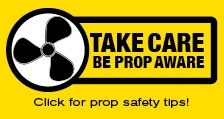Propeller, It’s What’s for Dinner : A Propeller Safety Checkoff Program
Many industries have created “checkoff” programs to generate funds to promote their “produce” or “product”. “Checkoff Programs” originally referred to programs where the manufacturer/producer was presented a checkoff box at time of sale they could check if they elected to participate in the program. Early programs were very successful, and more quickly followed. Some are mandatory, but they are often referred to as “Checkoff Programs” as well. Agriculture produce growers widely adopted Checkoff Programs. Funds are used to promote their produce in general, not a specific brand. Among the more popular agricultural checkoff programs are: “Beef, It’s What’s for Dinner” and “Got Milk”.
Manufacturing industries have also turned to the practice. “Discover Boating” is an example.We suggest a checkoff program for “Propellers” could be used to generate funds to promote recreational boat propeller safety. Currently, most of the focus on propeller accidents is on the manufacturer of the stern drive or outboard involved in the accident. The entire boating industry is benefiting from stern drive and outboard production, and most notably, those manufacturing propellers would be in a far different situation if outboards and stern drives did not exist. We suggest propeller manufacturers could shoulder at least a small portion of a major propeller safety initiative by voluntarily donating to checkoff funds.
As with other ideas we have suggested, we are not saying this program should be immediately adopted. We are just posting it to generate further discussion on the topic to see if there is interest in further refining it.
We also recognize some outboard and stern drive manufacturers are also major manufacturers or propellers, but most propeller manufacturers do not produce marine drives.
Propellers come in many shapes, sizes, materials, and costs. The bottom end of the market is pretty competitive. Stainless steel props for larger drives are often priced several times more per pound more than smaller props (very high markup on premium props). We suggest a staged checkoff price based on diameter that runs from about $.25 each for the small propellers to $1.00 for the large ones. Racing props would not be included in the program (racing fatalities are not included in U.S. Coast Guard Boating Accident Report Database – BARD).
Leaving plastic propellers out keeps us from interfering with the trolling motor market and with the very competitive economical, small propeller business.
The checkoff program could be entirely voluntary, a true “Check Off Program”. However, propeller manufacturers that find themselves in court, and fail to participate in the program, might risk additional ire from a judge and jury.
Colorful, educational graphics could be created and included on packaging and point of sale items identifying firms that donate as being concerned about your safety.
Funds raised by the checkoff could be overseen by a board similar to other checkoff programs. We suggested several possible uses of similar funds in our earlier post, Propeller Fatality Cap and Trade With a Tax On Over Cap Fatalities.
If Cap and Trade were adopted, funds raised by the checkoff program might be combined with those funds to administer a combined program. In real life, we suspect it would be better to keep the funds separate, but the boards could visit with each other and distribute the load (various propeller safety initiatives).
The National Marine Propeller Association might be a place to begin discussions if someone thought this might really be possible.
Estimates of annual U.S. propeller sales are all over the map, but if you look at the number of outboards and sterndrives produced annually, estimate the number of drives in the field, plus plugin a guess at propeller replacement frequency for drives in the field, and the number of boats carrying a spare prop, the number gets very big very fast. Several years ago we created a Boat Propeller Life Chart, surveyed hundreds of aluminum and stainless steel propeller owners on their replacement frequency, and made some guesses ourselves. Since then we have seen a few guesses made by others, but that is what they are, guesses.
If some guessed percentage of that guessed total number of propellers checked the box, we would have some guessed number of dollars to work with. As seen by the Discover Boating program, those percentages and the number of propellers may both strongly fluctuate with the economy.
We welcome your comments.
